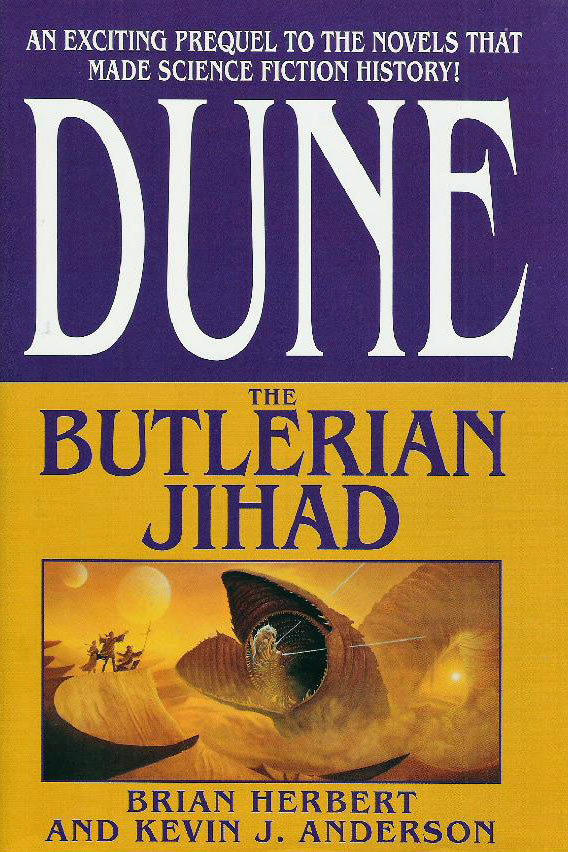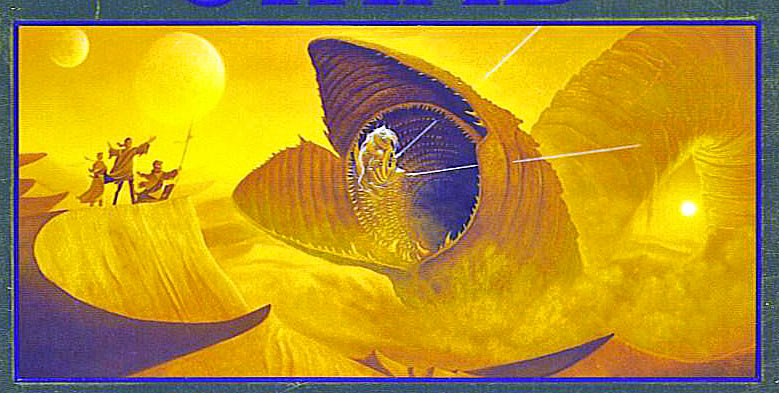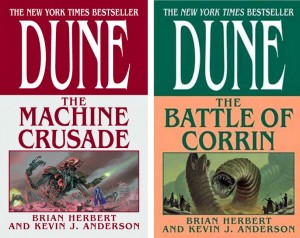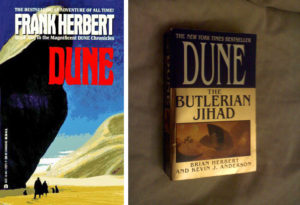
Back in 1992, the original Dune novel was my personal gateway into adult science fiction. First published in 1965, I was about eight-years-old when I read it cover to cover, and while most of the philosophical stuff went over my head (although it did make me start asking questions), much like a spice trance, Frank Herbert’s Dune opened my eyes to a much bigger literary world. I went on to read through Dune Messiah, Children of Dune and God Emperor of Dune, but only made it about 100 pages into Heretics of Dune (thus missing Chapterhouse: Dune altogether) before I became engulfed in the first wave of prequel novels written by Kevin J. Anderson and Herbert’s son, Brian Herbert.
Some time after the death of Frank Herbert in 1986, his son and other members of the Herbert estate uncovered notes by the author regarding extra Dune stories set outside and within the timeline of the first six novels. These notes were used as the outlines from which Anderson and Brian Herbert would write a dozen Dune spin offs (with a 13th installment teased for 2014), the first called House Atreides was published in 1999. Atreides begins a trilogy immediately preceding the first Dune book, starring the familiar cast of characters. Then the writing duo released a second trilogy, this time taking place thousands of years before Paul Muad’Dib and the Atreides’ rise to power, focusing on the fabled Butlerian Jihad where mankind wrested their freedom from the tyrannical thinking machines. If one were to read the Dune franchise in chronological order, this is where they’d begin.
Now, over ten years after reading any Dune books (save a joint reading of Dune with my fianceé three years ago), I have the urge to revisit the Dune universe from the beginning, and that means reading Dune: The Butlerian Jihad, published in 2002.
For Dune fans, this is a guilty pleasure read. It’s enjoyable and fast paced, but the philosophy is thinly veiled and the meta-messages aren’t nearly as layered as those in the original novels. This also makes it more accessible for the casual Dune fan. For people new to the franchise, Butlerian Jihad is a story of man vs. machine — artificial intelligence is massacring humanity with every opportunity, and only in the novel’s final act does mankind deliver a blow that resonates. It’s a prequel story, so we ultimately know how the events play out, but here we’re given the details…which are mostly grisly and traumatic.
The leading men are Xavier Harkonnen and Vorian Atreides — two notorious surnames found throughout the Dune mythos. In this story the antecedents of Paul Atreides and Feyd-Rautha Harkonnen come from polar opposite backgrounds and are two different hearts after the same woman in Serena Butler, whom the Jihad is named after. Vorian’s story is one of redemption, while Xavier’s is that of the tragic hero. While the Atreides banner is the one I’d pledge allegiance to in the later Dune stories, here the Harkonnen name bears more honor and Xavier is certainly a guy you root for. Vorian on the other hand begins as a servant of the machines, who quite frankly comes off as a tool. He becomes more likable as the story progresses, but Xavier is definitely the man who evokes emotion — especially considering the constant stream of tragedy he’s forced to endure throughout the book.
Comparatively, the other male characters are hit or miss. Ishmael and Aliid, the two slave boys on the planet Poritrin, are one dimensional, whereas Selim Wormrider of the planet Arrakis is a guy you eagerly await getting his due vengeance. Aurelius Venport and Tuk Keedair — two businessmen who deal in drugs and slaves, respectively — are there simply as plot devices. Keedair is a slaver who stumbles upon Arrakis and the spice. He then sells it to Venport, who specializes in the drug trade. The two men are obviously there to give reason for the spice Melange making it off of Arrakis and into the hands of the League of Nobles, eventually leading to a larger demand of the product that’s a staple theme in the original stories.
Similarly, Norma Cenva and Tio Holtzman, the science minds of Jihad who create weaponry and tech to combat the thinking machines and improve the human way of life, have interesting moments but mostly are another duo plot device. They create glowglobes, suspensor fields, and most notably in the Dune jargon, the Holtzman Shields where fast movement won’t pass through them but slow movement will. Norma Cenva’s blunt appearance and humble love of science makes for an interesting dichotomy with the eccentric, fame seeking Holtzman. Unfortunately, for a scientist, Holtzman’s character makes some strange common sense decisions not fitting a man of his intelligence, most notably purchasing a cadre of slaves from Keedair — these slaves were described in the book as an unruly, aggressive sort, yet Holtzman bought them to work in his laboratories anyway without thinking this may come back to bite him down the line. Which it does. Too often the pair’s scenes read like, “Hey, there’s all this tech that transcends throughout the entire Dune franchise. So who invented it all? These guys!”
To complete the transparent trifecta are Zufa Cenva and the psychic sisters of the planet Rossak, where Venport also resides. These women possess immense telepathic abilities and focus on selective breeding to produce near-perfect humans of maximum potential. What group from the original Dune novels does this sound like? The women of Rossak are not as mysterious and cryptic as the Bene Gesserit, although their combat scenes are intense. Conflictingly, the women of Rossak are described as gorgeous whereas the Bene Gesserit sisters, save Jessica and the less apt Princess Irulan, all reminded me of the nuns who stalked the hallways in my elementary school.
Fortunately, Butlerian Jihad bookends its protagonists Vorian and Xavier with a strong core of villains. Omnius is the computer evermind throughout the Synchronized Worlds who leads the crusade against humanity, and Erasmus is his number one. Erasmus is unique in that he’s the only robot to develop an independent personality. The machine is obsessed with understanding humans, to the chagrin of Omnius, and in doing so performs some sick experiments — the one that resonates most is when he dissects the brains of two twin little girls. This is but a glimpse of the horrors he concocts throughout the book and he creates the inciting incident which sparks the Jihad — a shocking and devastating scene handled extremely well by the book’s authors. In short, Erasmus is a sick, twisted bastard whose intentions are questionable, lacking any moral code or sense of sympathy.
A majority of Erasmus’s scenes are with leading lady Serena Butler. The underlying terror that grips Serena in her conversations with Erasmus, who only wants to better understand mankind, are some of the highlights of the book and the most anticipated scenes; this is where the most compelling dialog is found, complete with a sense of impending tragedy. The way Serena steels herself in the presence of the robot makes you really want her to make it out of her captive situation intact. She’s a strong character — more clever than, say, Princess Leia, but with less combat prowess.
The best villains of the book, though, are the Cymeks — human brains contained inside machine battle forms. The leading Cymeks are known as the Titans, who are thousands of years old. Long before the events in Jihad, the Titans were a group of ambitious people who led a revolt against lazy humanity — mankind had come to rely on machines to do everything for them, becoming complacent, and the Titans swooped in to conquer humanity. In becoming Cymeks, they preserved their own minds in immortal metal bodies and ruled over mankind until their ambition eventually got the better of them, leading to the robots becoming cognizant and the eventual thinking machine takeover. Omnius allows the Cymeks to live due to a programming clause keeping the machines from turning against them. The Cymeks are truly terrifying — they have the durability and firepower of any thinking machine, but the cunning and deception of a human. They’re ruthless and serve as a wild card in the war in that they hate humans, but they hate Omnius, too.
The leading Cymek, General Agamemnon, is the father of Vorian Atreides, who was grown in a lab from preserved sperm samples of the general before he was converted into a Cymek. One of the creepiest scenes of the book is when Vorian ceremoniously cleans his father’s brain canister. It’s equal parts erotic, reverent and just plain weird. It’s bizarre to think, too, that Paul Atreides and his father Leto come from the same stock as Agamemnon.
Finally, Jihad introduces the Cogitors — human minds who have been detached from their physical bodies, like Cymeks, but who only wish to live in peace and ponder the existence of the universe. Overall, these circular talking brains quickly become annoying to both the characters in the book and the reader with their indecisiveness. A cogitor plays a key role in the development of Iblis Ginjo, a slavemaster on the Omnius controlled ancient Earth, as it fuels the man’s rebellion against the machines. Gingo reminds me a lot of Borsk Fey’lya from the Star Wars expanded universe lore. He’s a politician who believes in good but uses his power and position to serve his own means.
Considering this is the introductory novel in a trilogy, there is a lot of exposition and therefore the experience is mostly sensational as opposed to lasting. The book makes the immense Dune universe feel small — readers familiar with the first three Frank Herbert novels may find many correlations with characters and themes in Jihad that often tiptoe along the line of being too conveniently connected. The reader’s willing suspension of disbelief is tested when contemplating why the machine evermind, Omnius, doesn’t obliterate mankind outright. The reasoning provided is porous. Additionally, there are moments of robotic emotion from both Omnius and Erasmus that seem to contradict the overall “mental mechanics” of the machines.
All this being said, Dune fans can appreciate and enjoy what this book accomplishes in expanding the Dune mythos. I had a lot of fun reading it; the future Earth setting that expands throughout the cosmos is cool, and regardless of where you stand in terms of your Dune knowledge, this is an accessible read for any sci-fi fan. If you like stories with themes of evil robotic characters in a dystopian future haloed by the hope of the human spirit, then Dune: The Butlerian Jihad is for you.
Andy Liegl
andy@comicattack.net





The Enemy is not Skynet.
“The book makes the immense Dune universe feel small — readers familiar with the first three Frank Herbert novels may find many correlations with characters and themes in Jihad that often tiptoe along the line of being too conveniently connected.”
1) The first three ? Saying this kind of implies these abominations are part of Dune, which is wrong on too many levels to explain to someone who thinks cleaning the brain bits of your dad can be erotic;
2) Frank tiptoed indeed, KJA just tramps all over that delicate construction, like a bull in a china shop (and a real bull, not the ultramegasupeawesome four(or is it eight?)horned piss contest idiocy.
I don’t understand — you seem very angry these non-FH works exist.
Are you more in a rage over that or this review?
Consider the question, what is a ‘fan of Dune’? Obviously someone who enjoyed the first novel by Frank Herbert, who marvelled at the rich texture of the fictional universe, at the way the author managed to describe the thoughts of characters who are supposed to be much more intelligent and perceptive than the average human.
The prequel novel—singular—that I’ve read had none of this. It seemed to be aimed squarely at young adults. No inner monologues, no outfreyn political theory. It was basically a prequel to the story of Dune, but without any of the things that ever made the original worthwhile to me.
So there are ‘Dune fans’—people who have only read the original novel, or the sequels by Frank Herbert; these are probably the largest group, and then there are ‘Dune fans’, who love the fictional universe and like to see the blanks filled in. Or who perhaps enjoy the writing style employed in the prequels. I take it your review was aimed with the latter group in mind?
Pingback: Press Release: ‘Dune: House Atredies’ Comes to BOOM! – ComicAttack.net